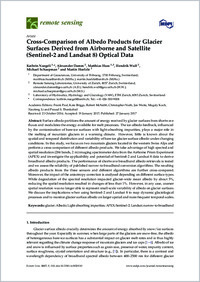Cross-comparison of albedo products for glacier surfaces derived from airborne and satellite (sentinel-2 and landsat 8) optical data
- Naegeli, Kathrin Department of Geosciences, University of Fribourg, Switzerland
- Damm, Alexander Remote Sensing Laboratories, University of Zurich, Switzerland
- Huss, Matthias Department of Geosciences, University of Fribourg, Switzerland - Laboratory of Hydraulics, Hydrology and Glaciology (VAW), ETH Zurich, Switzerland
- Wulf, Hendrik Remote Sensing Laboratories, University of Zurich, Switzerland
- Schaepman, Michael Remote Sensing Laboratories, University of Zurich, Switzerland
- Hoelzle, Martin Department of Geosciences, University of Fribourg, Switzerland
-
27.01.2017
Published in:
- Remote Sensing. - 2017, vol. 9, no. 2, p. 110
English
Surface albedo partitions the amount of energy received by glacier surfaces from shortwave fluxes and modulates the energy available for melt processes. The ice- albedo feedback, influenced by the contamination of bare-ice surfaces with light- absorbing impurities, plays a major role in the melting of mountain glaciers in a warming climate. However, little is known about the spatial and temporal distribution and variability of bare-ice glacier surface albedo under changing conditions. In this study, we focus on two mountain glaciers located in the western Swiss Alps and perform a cross-comparison of different albedo products. We take advantage of high spectral and spatial resolution (284 bands, 2 m) imaging spectrometer data from the Airborne Prism Experiment (APEX) and investigate the applicability and potential of Sentinel-2 and Landsat 8 data to derive broadband albedo products. The performance of shortwave broadband albedo retrievals is tested and we assess the reliability of published narrow-to-broadband conversion algorithms. The resulting albedo products from the three sensors and different algorithms are further cross-compared. Moreover, the impact of the anisotropy correction is analysed depending on different surface types. While degradation of the spectral resolution impacted glacier-wide mean albedo by about 5%, reducing the spatial resolution resulted in changes of less than 1%. However, in any case, coarser spatial resolution was no longer able to represent small-scale variability of albedo on glacier surfaces. We discuss the implications when using Sentinel-2 and Landsat 8 to map dynamic glaciological processes and to monitor glacier surface albedo on larger spatial and more frequent temporal scales.
- Faculty
- Faculté des sciences et de médecine
- Department
- Département de Géosciences
- Language
-
- English
- Classification
- Hydrology
- License
-
License undefined
- Identifiers
-
- RERO DOC 279100
- DOI 10.3390/rs9020110
- Persistent URL
- https://folia.unifr.ch/unifr/documents/305210
Statistics
Document views: 141
File downloads:
- pdf: 286
